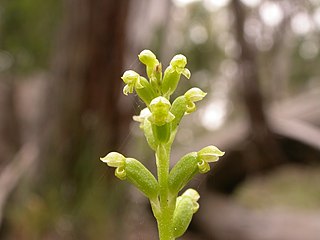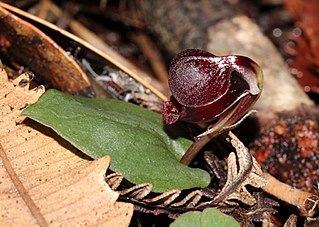
Caladenia carnea, commonly known as pink fingers, is a plant in the orchid family Orchidaceae and is endemic to eastern and south-eastern Australia, including Tasmania. It has a single thin, green leaf and one to five white or pink flowers with red stripes and two rows of yellow-tipped "calli" on their labellum.

Pterostylis curta, commonly known as the blunt greenhood, is a species of orchid found in south-eastern Australia, Lord Howe Island and New Caledonia. It has a rosette of leaves at its base and a single white and green, forward leaning flower with a brown tip and a twisted labellum.

Sarcochilus falcatus, commonly known as the orange blossom orchid, is a small epiphytic or lithophytic orchid that is endemic to eastern Australia. It has up to eight, leathery leaves with fine teeth on the edges and up to twelve white to cream-coloured flowers with a white labellum that has orange and purple markings.

Calochilus, commonly known as beard orchids, is a genus of about 30 species of plants in the orchid family, Orchidaceae. Beard orchids are terrestrial herbs with a single leaf at the base of the plant, or no leaves. Their most striking feature is a densely hairy labellum, giving rise to their common name. Beard orchids, unlike some other Australian orchids, do not reproduce using daughter tubers, but self-pollinate when cross-pollination has not occurred. Most species occur in Australia but some are found in New Zealand, New Guinea and New Caledonia.

Acianthus fornicatus, commonly known as pixie cap, is a flowering plant in the orchid family Orchidaceae and is endemic to New South Wales and Queensland in Australia. It is a terrestrial herb with a single, heart-shaped leaf and up to ten translucent pinkish-red flowers and which is widespread and common in coastal and near-coastal areas.

Calochilus paludosus, commonly known as the red beard orchid or red beardie, is a species of orchid native to Australia and New Zealand. It has a single fleshy, light green leaf and up to nine greenish flowers with reddish stripes. The labellum has a dull red or coppery coloured beard and lacks the "eye" spots of other beard orchids.

Orthoceras strictum, commonly known as the bird's-mouth orchid or horned orchid, is a species of orchid native to eastern and southern Australia, New Zealand and New Caledonia. It has between two and five linear leaves and up to nine yellowish green, brownish or blackish flowers with two long, erect to spreading lateral sepals.

Microtis parviflora, commonly known as the slender onion-orchid, is a species of orchid which is native to Australia and New Zealand. It occurs in all states of Australia but is not known from the Northern Territory and may not occur in Western Australia. As with others in the genus, it has a single erect, smooth, tubular leaf and up to eighty flowers on an erect flower spike.

Acianthus exsertus, commonly known as gnat orchid or large mosquito orchid, is a flowering plant in the orchid family Orchidaceae and is endemic to eastern Australia. It is a terrestrial herb with a single, heart-shaped leaf and up to 25 small, fine, dark brown flowers with pinkish and purplish markings and is found growing in sheltered places in forests in Queensland, New South Wales the ACT and Victoria.

Pterostylis squamata, commonly known as the southern rustyhood or ruddyhood, is a plant in the orchid family Orchidaceae and is endemic to south-eastern Australia. Flowering plants have up to ten translucent green flowers with reddish-brown markings and a hairy, insect-like labellum. Non-flowering plants have a rosette of four to eight egg-shaped leaves. This species is very similar to Pterostylis rufa which has a narrower labellum and other minor differences.
Pterostylis gibbosa, commonly known as the Illawarra rustyhood, or Illawarra greenhood, is a plant in the orchid family Orchidaceae and is endemic to New South Wales. It has a rosette of leaves at its base and up to nine bright green flowers with translucent "windows", relatively wide lateral sepals with short-pointed tips and a dark, fleshy, insect-like labellum.
Corunastylis nigricans, commonly known as the Kangaroo Island midge orchid is a small terrestrial orchid endemic to South Australia. It has a single thin leaf and up to twenty five purplish brown flowers with a shiny, hairless, dark purplish labellum. It is sometimes confused with Genoplesium nigricans which has differently coloured flowers and a much wider distribution. It is regarded as a synonym of G. nigricans by the World Checklist of Selected Plant Families.
Genoplesium baueri, commonly known as the brittle midge orchid, is a small terrestrial orchid which is endemic to New South Wales. It has a single thin leaf and up to nine yellowish green to reddish brown flowers. It is mostly only found in coastal and near-coastal heath and woodland between Port Stephens and Ulladulla.
Microtis rara, commonly known as the scented onion orchid, is a species of orchid endemic to Australia, with the exception of the Northern Territory. It has a single hollow, onion-like leaf and up to fifty small green or yellowish-green, scented flowers. It is similar to Microtis oblonga and some authorities regard the two as being one species.

Corybas fimbriatus, commonly known as the fringed helmet orchid, is a species of terrestrial orchid endemic to eastern Australia. It has a broad egg-shaped to round leaf and a dark reddish purple to crimson flower with translucent patches. It is similar to C. hispidus but its labellum lacks a creamy-white centre and is not covered with bristly hairs.

Corybas unguiculatus, commonly known as the small helmet orchid or pelicans, is a species of terrestrial orchid endemic to south-eastern Australia. It is a widespread, sometimes common but small orchid with a single leaf and a single reddish purple to reddish black flower.
Thelymitra media, commonly called the tall sun orchid, is a species of orchid that is endemic to eastern Australia. It has a single fleshy, channelled leaf and up to thirty blue flowers with darker streaks but without spots. The labellum is narrower than the other petals and sepals.
Thelymitra venosa, commonly known as the large veined sun orchid, is a species of orchid that is endemic to New South Wales. It has a single fleshy, channelled leaf and up to six relatively large, bright-blue flowers with darker veins. The arms on the side of the column are twisted and yellow, but not toothed at the tip. Unlike most other thelymitras, the flowers do not usually close on cloudy days.

Calochilus herbaceus, commonly known as the pale beard orchid, is a species of orchid native to south-eastern Australia and northern New Zealand. It has a single very short, rigid, fleshy leaf and up to eight pale green to brownish flowers with reddish stripes and a purple "beard".
Dendrobium rigidum, commonly known as the smooth tongue orchid or smooth tick orchid, is a species of orchid native to tropical North Queensland and to New Guinea. It is an epiphytic or lithophytic orchid with wiry, hanging stems, fleshy, dark green leaves and flowering stems with between two and seven crowded, cream-coloured, star-shaped flowers often with pink or red on the back. It grows on trees, shrubs and rocks in a paperbark swamps and rainforest.













